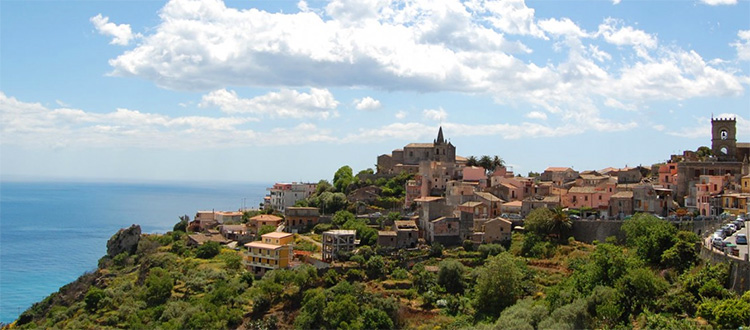Forza d’Agrò
Forza d’Agrò
Surrounded by steep ravines, breathtaking views, it seems a moving canvas. Here there is a tranquility that only it can give, 420 meters above the level of Messina’s Mediterranean Ionian Sea, lodged high in Agrò Valley, a truly suggestive Sicilian jewel. Forza d’Agrò.
Numerous archaeological discoveries, made in recent years, near the Forza castle, have shown that the site was inhabited both in prehistoric times and in later eras such as the Greek, Hellenistic and Roman periods.
Like a balcony looking over the Ionian Sea from its special vantage you can admire the coast from Messina to Syracuse. Taormina and Castelmola, the bay of Giardini Naxos and the imposing vulcano of Mount Etna.
In 1971, the historic center of Forzà d’Agro (along with Savoca) was chosen by Francis Ford Coppola as the setting for several scenes in the series of films telling the story of the saga of the Corleone family. Among the most famous of these was The Godfather.
The History of Forza d’Agrò
Its history is richly colorful because of the numerous invasions that have taken place over the centuries. The Greeks were the first to settle there between the seventh and fifth centuries BC. They first gave it the name ARGHENNON AKRON, i.e. “the silver cape”, then later it became ARGON ‘AGRON.
With the Roman conquest of 135 BC the place lost its Greek connotation. It assumed the Latin name of Agrillae. The village and the existing groups of dwellings in the valley assumed the name of Vicum Agrillae.
Around the seventh century Arab raids became increasingly frequent. In 1091 Count Roger the Norman managed to give a little confidence, mastery and self-protection to a people too often the target of Arab invasions. Indeed it is Count Roger who is credited with the building Forza d’Agrò Castle.
Forza d’Agrò and Traditions
Forza d’Agrò definitely can definitely boast a total dedication to traditions, especially those religious. Of the various festivals and religious processions that are held in Forza d’Agrò one of particular folklore tradition is the centuries-old Holy Trinity feast. This derives from a painting kept in the church of the same name, depicting the visit of the three angels to Abraham. The festival consists of a friendly, fraternal and cordial meeting between the fraternities of Forza d’Agrò and Gallodoro and is held each year. The festival is held alternately in the two locations, with subsequent sharing of typical cuddure, or typical little round-shaped cakes. Equally important for the faithful is the feast of The Most Holy Crucifix (S.S. Crocifisso), patron saint of Forza d’Agrò, celebrated on September 14th each year.



